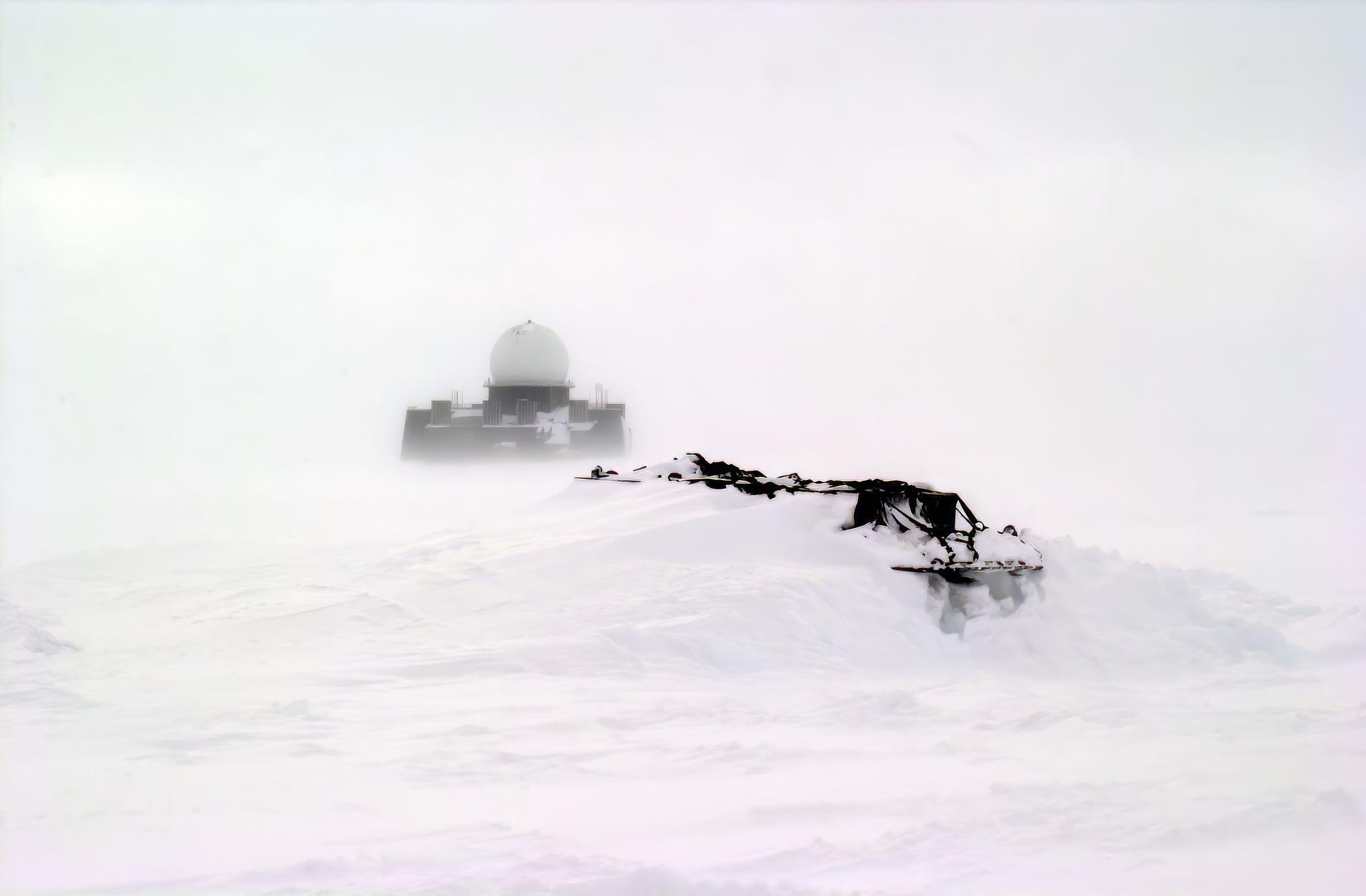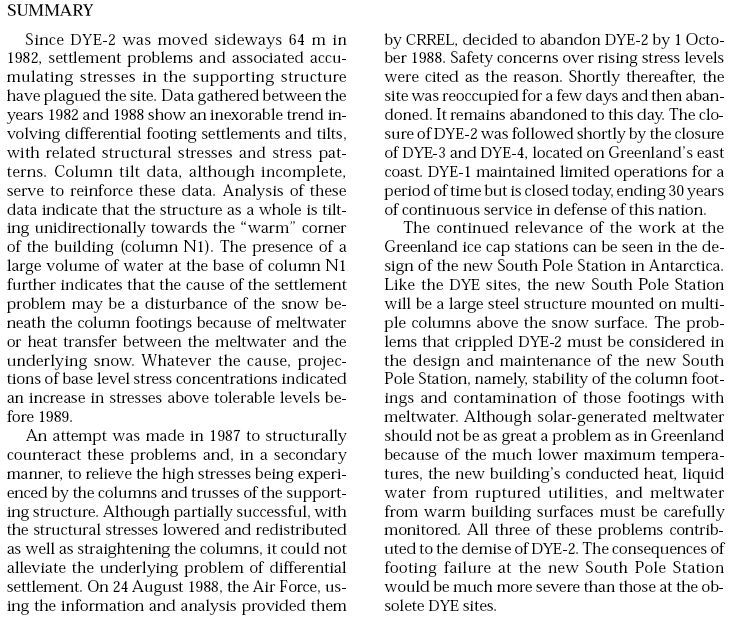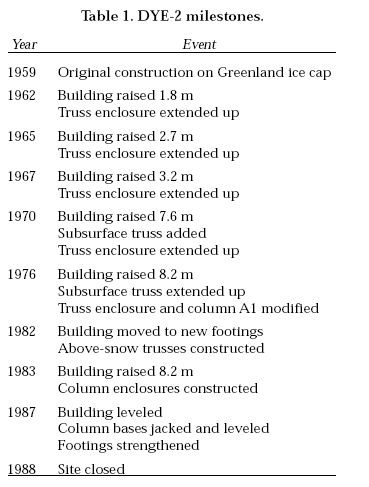DYE-2 Abstracts from the US Army Cold Regions Research & Engineering

While reviewing The DEWLine blog I came across some image abstracts provided by the author from the US Army Cold Regions Research & Engineering. In an effort to make these more searchable, I've reproduced the text of the images below.
On The Ice Caps Of Greenland

Located deep within the Arctic Circle, on the far northern island of Greenland, there are four radar sites that are part of the Distant Early Warning (DEW) Line--and two of these sites are built directly on Greenland's ice cap, appearing to "sink" into it.
Six-sevenths of Greenland is covered by a massive ice sheet with only the coastal areas free from the year-round ice burden. At the rate of approximately one-eighth of an inch per day (4.5 feet a year), the island's DYE-2 and DYE-3 radar sites are becoming a part of this "ice" environment.
The term "DYE" refers to Cape Dyer, Canada, the main station to which Greenland's four DEW Line sites report their operational data. The DEW Line is a continuous radar fence stretching from western Alaska, across the top of North America, to the east coast of Greenland. The system is a 3,600-mile network of 31 remote radar stations that, under contract with the U.S. Air Force, are operated and maintained by FELEC Services Inc., the Colorado Springs subsidiary of FEC.
The DEW Line's mission is the detection and reporting of airborne vehicles over the polar region and across the northern perimeter of the continent. The system is operated 24 hours-a-day, 7 days-a-week. FEC first became associated with the DEW Line in 1956 while the system was being built. The Alaskan and Canadian portion of the DEW Line became fully operational and began reporting radar data to the North American Air Defense (NORAD) Command in 1957.
In 1959, it became necessary to expand the nation's "eyes and ears" and to add more locations to the DEW Line in Greenland. The construction of additional radar stations in Greenland (DYE-1, DYE-2, DYE-3 and DYE-4), in the remote arctic wastes, was something of an engineering miracle.
DYE-2 and DYE-3 were built on a mass of snow and ice nearly 10,000 feet (2 miles) thick. Prior to this, nobody had ever built a permanent structure on the ice sheet. The geological and environmental aspects of the project required the development of new techniques in construction.
The Ice Cap sites stand 5 stories high (126-foot structures topped by a large radome) and weigh 5.2 million pounds. The buildings have living, working, and storage space of more than 45,000 square feet. The remainder of the space is taken up by the radar which is covered by a 55-foot white dome.
To permit blowing snow to pass under and to prevent drifts from forming, the DYE-2 and DYE-3 composite buildings were built on stilts. Eight steel columns were erected suspending a 5.2 million pound platform 20–30 feet above the snow.
The truth of the DYE sites "sinking" is that the buildings are not really descending, but instead the snow and ice are rising around them. This "problem" is not surprising or unexpected; in fact, the ice cap radar sites were designed and constructed to react to this snow build-up. The steel columns were built so that extensions could be added to allow for the periodic raising of the platform, by hydraulic jacks, to maintain a 20-30 foot ground clearance.
The useful life of the DYE sites was originally expected to be 20 years. However, soon after they were completed, problems began surfacing. It was discovered that the snow and ice build-up was faster than anticipated. Also, the ice cap was shifting ever so slightly toward the sea--creating considerable stress on the steel columns, bending beams and shattering wooden support braces.
Engineering studies were performed to compare various methods for extending the operational life of the radar units. In the past two decades, both DYE-2 and DYE-3 have had their columns extended to permit additional lifts. In 1977, rather than try to strengthen the existing foundation, it was decided to relocate DYE-3 to an entirely new set of foundation supports 210 feet west of the old site. In 1982, DYE-2 was also moved. Throughout all of the alterations, DYE-2 and DYE-3 maintained full communication capabilities, relaying their vital information.
Moving the DYE sites, building extensions, and periodically raising the units have given these radar stations an extended life. It has been over 25 years since the original DYE sites were completed and they still continue to be an essential link in the DEW Line surveillance and communications system.
Abstract

Abstract: DYE-2, a Distant Early Warning station, is located on the Greenland ice cap approximately along the Arctic Circle, 470 km from the west coast. The viscous nature of the material on which the structure is grounded made periodic monitoring and maintenance of the supporting structure necessary. This report analyses the stresses developed within the structure from the last major maintenance operation, a 64-m sideways move in 1982 to a new foundation, to the final set of stress measurements taken at the abandoned site in 1988. Conclusions drawn from these measurements and the subsequent analysis were that the building system was continuing to tilt in one direction because of differential footing settlement caused by changing footing conditions, and high structural stresses would make it unsafe for reoccupation after December of 1988 unless emergency maintenance was performed. The U.S. Air Force officially abandoned the site in August 1988 as a result of this analysis.
Summary

Since DYE-2 was moved sideways 64 m in 1982, settlement problems and associated accumulating stresses in the supporting structure have plagued the site. Data gathered between the years 1982 and 1988 show an inexorable trend involving differential footing settlements and tilts, with related structural stresses and stress patterns. Column tilt data, although incomplete, serve to reinforce these data. Analysis of these data indicate that the structure as a whole is tilting unidirectionally towards the "warm" corner of the building (column N1). The presence of a large volume of water at the base of column N1 further indicates that the cause of the settlement problem may be a disturbance of the snow beneath the column footings because of meltwater or heat transfer between the meltwater and the underlying snow. Whatever the cause, projections of base level stress concentrations indicated an increase in stresses above tolerable levels before 1989.
An attempt was made in 1987 to structurally counteract these problems and, in a secondary manner, to relieve the high stresses being experienced by the columns and trusses of the supporting structure. Although partially successful, with the structural stresses lowered and redistributed as well as straightening the columns, it could not alleviate the underlying problem of differential settlement. On 24 August 1988, the Air Force, using the information and analysis provided them by CRREL, decided to abandon DYE-2 by 1 October 1988. Safety concerns over rising stress levels were cited as the reason. Shortly thereafter, the site was reoccupied for a few days and then abandoned. It remains abandoned to this day. The closure of DYE-2 was followed shortly by the closure of DYB-3 and DYE-4, located on Greenland's east coast. DYE-1 maintained limited operations for a period of time but is closed today, ending 30 years of continuous service in defense of this nation.
The continued relevance of the work at the Greenland ice cap stations can be seen in the design of the new South Pole Station in Antarctica. Like the DYE sites, the new South Pole Station will be a large steel structure mounted on multiple columns above the snow surface. The problems that crippled DYE-2 must be considered in the design and maintenance of the new South Pole Station, namely, stability of the column footings and contamination of those footings with meltwater. Although solar-generated meltwater should not be as great a problem as in Greenland because of the much lower maximum temperatures, the new building's conducted heat, liquid water from ruptured utilities, and meltwater from warm building surfaces must be carefully monitored. All three of these problems contributed to the demise of DYE-2. The consequences of footing failure at the new South Pole Station would be much more severe than those at the obsolete DYE sites.
Table 1. DYE-2 milestones.

1959
Original construction on Greenland ice cap
1962
Building raised 1.8 m
Truss enclosure extended up
1965
Building raised 2.7 m
Truss enclosure extended up
1967
Building raised 3.2 m
Truss enclosure extended up
1970
Bulling raised 7.6 m
Subsurface truss added
Truss enclosure extended up
1976
Building raised 8.2 m
Subsurface truss extended up
Truss enclosure and column A1 modified
1982
Building moved to new footings
Above-snow trusses constructed
1983
Building raised 8.2 m
Column enclosures constructed
1987
Building leveled
Column bases lacked and leveled
Footings strengthened
1988
Site closed